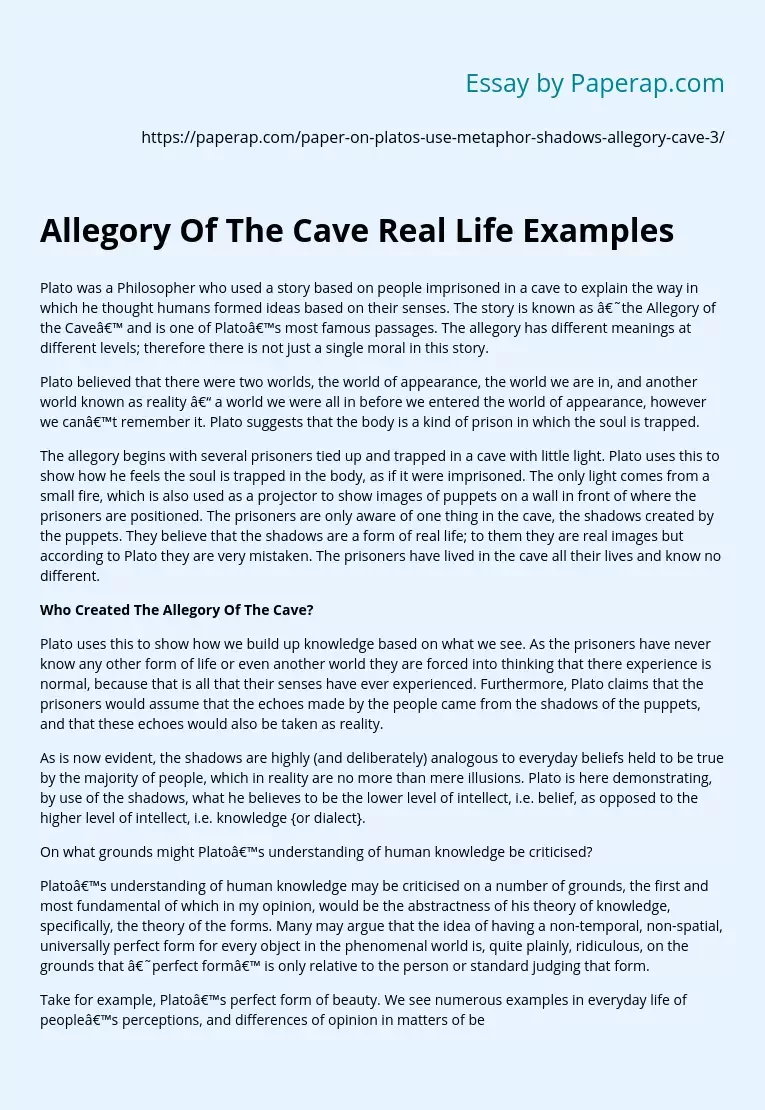Allegory Of The Cave Real Life Examples
Plato was a Philosopher who used a story based on people imprisoned in a cave to explain the way in which he thought humans formed ideas based on their senses. The story is known as ‘the Allegory of the Cave’ and is one of Plato’s most famous passages. The allegory has different meanings at different levels; therefore there is not just a single moral in this story.
Plato believed that there were two worlds, the world of appearance, the world we are in, and another world known as reality – a world we were all in before we entered the world of appearance, however we can’t remember it.
Plato suggests that the body is a kind of prison in which the soul is trapped.
The allegory begins with several prisoners tied up and trapped in a cave with little light. Plato uses this to show how he feels the soul is trapped in the body, as if it were imprisoned.
The only light comes from a small fire, which is also used as a projector to show images of puppets on a wall in front of where the prisoners are positioned. The prisoners are only aware of one thing in the cave, the shadows created by the puppets. They believe that the shadows are a form of real life; to them they are real images but according to Plato they are very mistaken. The prisoners have lived in the cave all their lives and know no different.
Who Created The Allegory Of The Cave?
Plato uses this to show how we build up knowledge based on what we see.
As the prisoners have never know any other form of life or even another world they are forced into thinking that there experience is normal, because that is all that their senses have ever experienced. Furthermore, Plato claims that the prisoners would assume that the echoes made by the people came from the shadows of the puppets, and that these echoes would also be taken as reality.
As is now evident, the shadows are highly analogous to everyday beliefs held to be true by the majority of people, which in reality are no more than mere illusions. Plato is here demonstrating, by use of the shadows, what he believes to be the lower level of intellect, i.e. belief, as opposed to the higher level of intellect, i.e. knowledge or dialect.
On what grounds might Plato’s understanding of human knowledge be criticised?
Plato’s understanding of human knowledge may be criticised on a number of grounds, the first and most fundamental of which in my opinion, would be the abstractness of his theory of knowledge, specifically, the theory of the forms. Many may argue that the idea of having a non-temporal, non-spatial, universally perfect form for every object in the phenomenal world is, quite plainly, ridiculous, on the grounds that ‘perfect form’ is only relative to the person or standard judging that form.
Take for example, Plato’s perfect form of beauty. We see numerous examples in everyday life of people’s perceptions, and differences of opinion in matters of beauty; in relation to art, sexual partners, cars, in fact almost anything. The idea that the amount of beauty in the above things can be agreed upon by every single person seems absurd enough, never mind the absurdity of a ‘universal’ form of beauty being agreed upon.
The elitism of Plato’s understanding may also be criticised, as it may seem immoral to some because of the arrogance portrayed by him. What Plato is actually claiming is that only a tiny minority of people like himself have true understanding, and that the rest are ignorant and wrong.
Plato’s attitude is summed up by his quotation of Homer, to illustrate his point, effectively saying how he would rather be a “surf in the house of some landless man than live and think as they do”. A further criticism would be that Plato’s understanding of knowledge has no practical relevance, as it gives no indication or guide as to how to achieve the higher levels of intellect or, more importantly, how to apply his theory to the moral field of making everyday decisions.
Allegory Of The Cave Real Life Examples. (2019, Dec 05). Retrieved from https://paperap.com/paper-on-platos-use-metaphor-shadows-allegory-cave-3/

